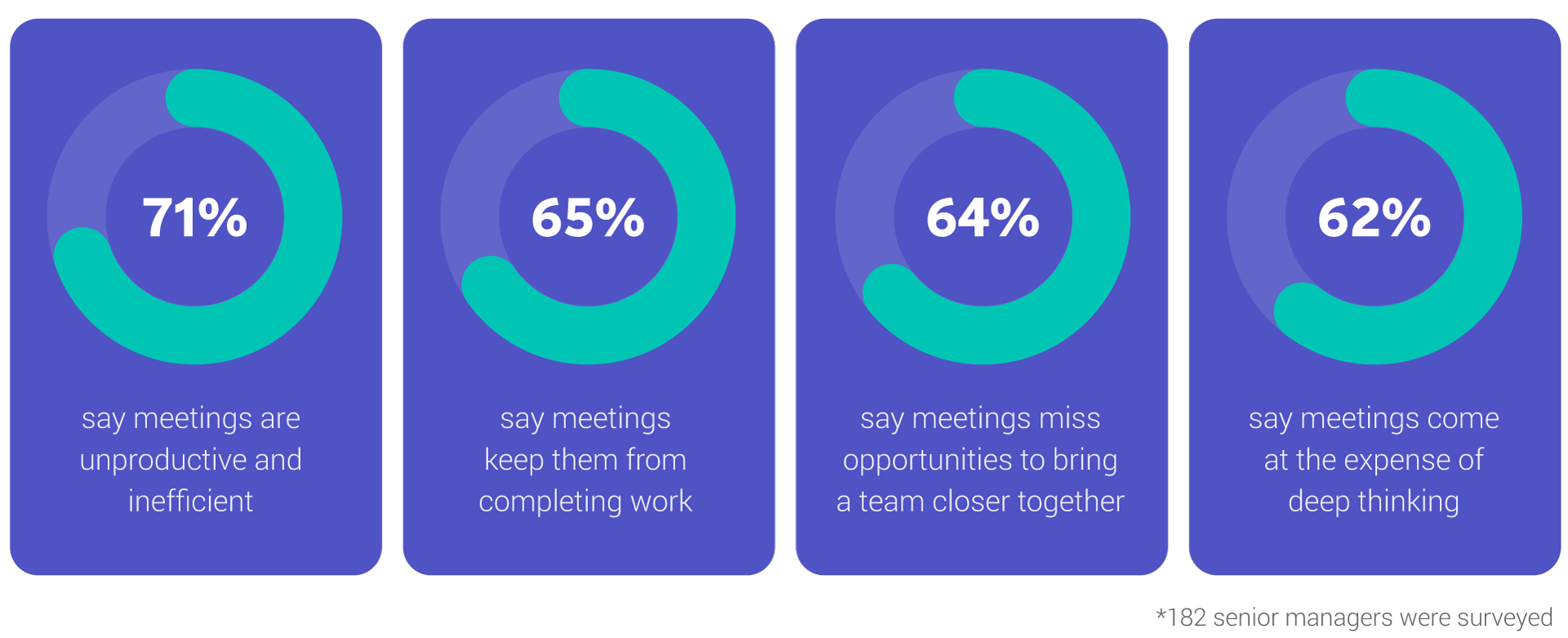When it comes to project teams, there is never a shortage of meetings. They can help get a lot done in a short amount of time; however, ineffective meetings can be a time waster, and possibly even become a root cause of project delays. According to a survey of senior managers conducted by Harvard Business Review:

There are many ways that meetings can descend into disorganization, but researchers have identified the following three points to be the root causes of ineffective meetings:
- Lacks Clarity of Purpose
- Wrong Format for the Audience
- Lacks Action
How would you rate the effectiveness of the meetings you attend or those you facilitate? Not great? Try something different today!
#1 Plan Your Meeting
Getting into the rhythm of planning meetings can feel strange, especially the ones at your organization tend to have a more “improvisational” feel. These tips will help you stick out in a good way (no sore thumbs here!):
- Set an objective: Take some time to figure out what exactly you want from the meeting and communicate this to participants at the very beginning, or even ahead of time.
- Create an agenda: This will help focus discussion and work toward your objective. Feel free to allocate chunks of time to each agenda item to make sure you don’t spend too much time on any one thing.
- Take notes: If things start to get off-topic, let your colleague know (politely!) that while their concern is legitimate, it may be better answered elsewhere. Make a note to get back to them later.
#2 Select the Right Format and Frequency
The Daily Check
Your daily should follow a few basic principles:
- Everyone on the project team attends.
- Time allotted: 15 minutes, usually 1st thing in the morning.
- This is not a status update! Focus on WHO needs to talk with WHOM so progress continues.
To discourage people from giving a status update, all team members should focus on answering 3 main questions:
- What did you work on yesterday? (Consider the completion day in case there is a hand-off.)
- What do you plan to work on? (Consider work today and who you might need to talk to.)
- What impediments are standing in the way of getting work done?
A daily meeting to reduce the number of meetings may feel like a bit of a contradiction. Still, a singular, daily check-in can be a big help your team. A daily makes sure everyone is on the same page, so things don’t fall through the cracks. To this end, the daily frequency means people can offer help regularly and keep things moving so fires don’t have to be fought later on. It also helps eliminate the need for unnecessary and time-consuming email chains that often need clarification anyways.
The Weekly Tactical Meeting
Once more, a few basic principles for your weekly:
- Everyone always attends. It is run with discipline and structural consistency.
- Time allotted: 45-90 minutes.
- Focused exclusively on tactical issues of immediate concern.
Additionally, consider using a few elements to focus on those most-critical tactical topics and lend some structure to the meeting each week:
- Lightning Round: Everyone quickly takes a turn reporting their 2-3 priorities for the week. Should take less than 1 minute for each team member.
- Progress Review: Routine reporting of critical information or metrics. No more than 5 minutes.
- Real-time Agenda: The agenda should be based on what everyone is actually working on and how the company is performing against its goals. Allow the meeting to take shape during the meeting.
Pro Tip
Keep milestones visible to everybody and ask the question “In order to hit these milestones, these things need to be done. How are you tracking?” Dig deeper if progress is not being made.
The Ad-hoc Strategy Meeting
- Focused solely on the topics raised. Dive into a given topic(s) without the distractions of deadlines and tactical concerns.
- Time allotted: 2 hours per topic.
- Allows team members to engage in open-ended conversation and debate.
- Serves as a warehouse for critical strategic issues that come up during the weekly tactical meetings.
Pro Tip
Create meeting ‘ground rules’ like: (1) don’t talk over each other, (2) focus on decisions & outcomes, (3) no muti-tasking, and/or (4) if you have something that is urgent, step out.
#3 Always End With a Wrap-up
Confirm Key Decisions and Next Steps
Recap what was decided in the meeting, who is accountable for following through, when implementation will occur, and how it will be communicated. You want every attendee to leave the meeting with the same understanding of what was agreed upon and what they have to do, so there’s little chance anyone will need further meetings.
Share Meeting Minutes
Send out meeting minutes to ensure optional attendees feel informed. Mark action or follow-up tasks, the assignee’s name, and the due date clearly with bold or a highlighter.
Gather Session Feedback
When meeting with the same group, ask attendees once in a while for feedback on the session while it’s fresh in their minds. This is an oft-missed opportunity to learn both what people liked and what they would change. Ask for positives and negatives instead of the typical “What feedback do you have?”
Develop Communication Points
For longer meetings, like the Ad-hoc Strategy Meeting, develop communication points after the session for colleagues not at the meeting. Before wrapping up, pose the question to the group: “What are the most important things we accomplished here?” Also ask “Is there any part of the discussion that we don’t need to share?” so everyone clearly understands what decisions in the meeting were the most important.
After the meeting, send your agreed-upon talking points to everyone in an email as soon as possible.
In Summary
“There are benefits of having fewer meetings.” According to Harvard Business Review, “productivity was 71% higher when meetings were reduced by 40%. This is largely because employees felt more empowered and autonomous. Rather than a schedule being the boss, they owned their own to-do lists and held themselves accountable, which consequently increased their satisfaction by 52%.”
Don’t delay in evaluating your meetings today — you can’t afford to wait. Estimate the Cost of a Meeting with This Calculator (hbr.org)



